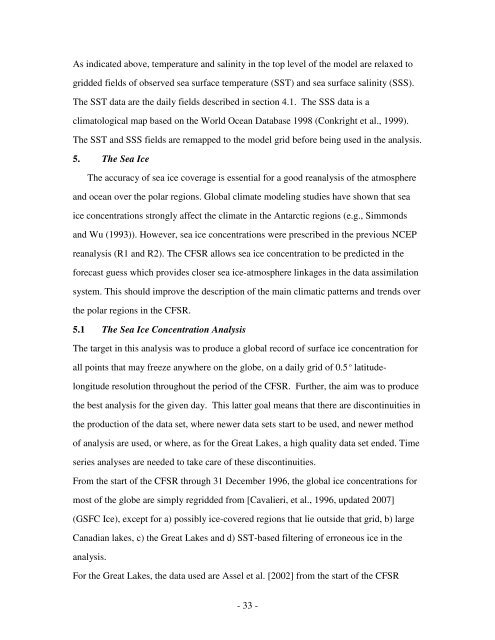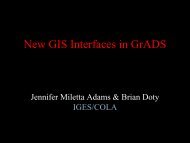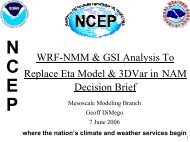The NCEP Climate Forecast System Reanalysis - NOAA National ...
The NCEP Climate Forecast System Reanalysis - NOAA National ...
The NCEP Climate Forecast System Reanalysis - NOAA National ...
Create successful ePaper yourself
Turn your PDF publications into a flip-book with our unique Google optimized e-Paper software.
As indicated above, temperature and salinity in the top level of the model are relaxed togridded fields of observed sea surface temperature (SST) and sea surface salinity (SSS).<strong>The</strong> SST data are the daily fields described in section 4.1. <strong>The</strong> SSS data is aclimatological map based on the World Ocean Database 1998 (Conkright et al., 1999).<strong>The</strong> SST and SSS fields are remapped to the model grid before being used in the analysis.5. <strong>The</strong> Sea Ice<strong>The</strong> accuracy of sea ice coverage is essential for a good reanalysis of the atmosphereand ocean over the polar regions. Global climate modeling studies have shown that seaice concentrations strongly affect the climate in the Antarctic regions (e.g., Simmondsand Wu (1993)). However, sea ice concentrations were prescribed in the previous <strong>NCEP</strong>reanalysis (R1 and R2). <strong>The</strong> CFSR allows sea ice concentration to be predicted in theforecast guess which provides closer sea ice-atmosphere linkages in the data assimilationsystem. This should improve the description of the main climatic patterns and trends overthe polar regions in the CFSR.5.1 <strong>The</strong> Sea Ice Concentration Analysis<strong>The</strong> target in this analysis was to produce a global record of surface ice concentration forall points that may freeze anywhere on the globe, on a daily grid of 0.5 o latitudelongituderesolution throughout the period of the CFSR. Further, the aim was to producethe best analysis for the given day. This latter goal means that there are discontinuities inthe production of the data set, where newer data sets start to be used, and newer methodof analysis are used, or where, as for the Great Lakes, a high quality data set ended. Timeseries analyses are needed to take care of these discontinuities.From the start of the CFSR through 31 December 1996, the global ice concentrations formost of the globe are simply regridded from [Cavalieri, et al., 1996, updated 2007](GSFC Ice), except for a) possibly ice-covered regions that lie outside that grid, b) largeCanadian lakes, c) the Great Lakes and d) SST-based filtering of erroneous ice in theanalysis.For the Great Lakes, the data used are Assel et al. [2002] from the start of the CFSR- 33 -





